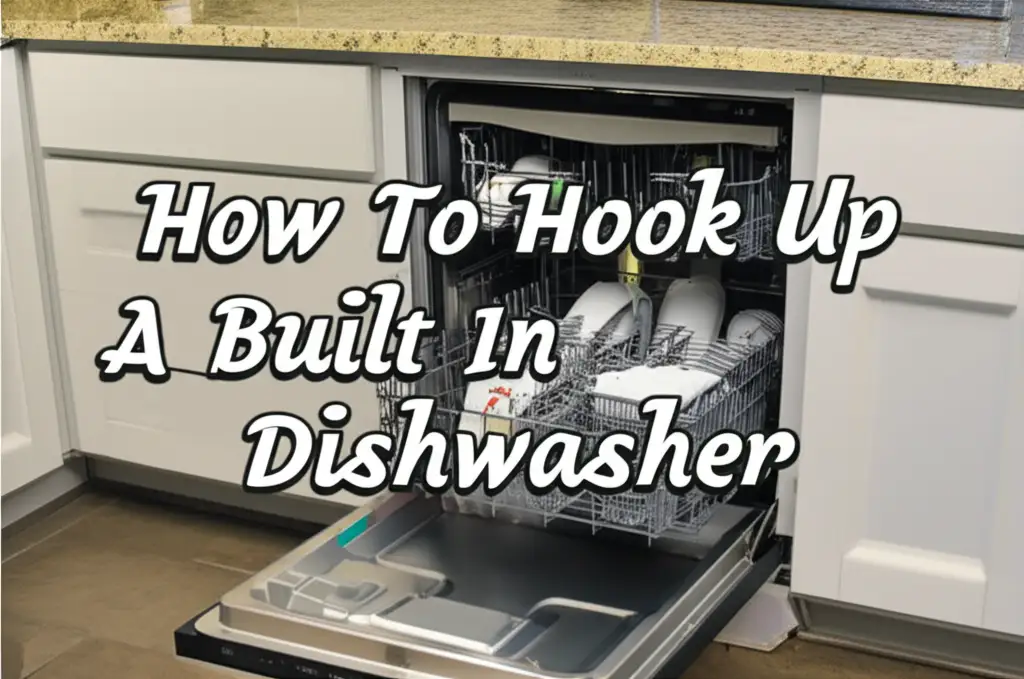· Tessa Winslow · Home Improvement · 19 min read
How To Hook Up A Built In Dishwasher

How To Hook Up A Built In Dishwasher
Installing a new dishwasher can feel like a big project. You might wonder if it is something you can do yourself. I remember feeling the same way the first time I faced this task. The good news is that connecting a built-in dishwasher is a manageable DIY job for many homeowners. This guide will walk you through each step. We will cover everything from safety checks to the final test run. You will learn how to hook up a built-in dishwasher safely and effectively. This will help you save on installation costs and get your kitchen running smoothly again.
Takeaway
- Gather Tools: Collect all necessary tools and parts before starting.
- Prioritize Safety: Always turn off power and water before starting work.
- Follow Steps: Connect water, drain, and electrical lines in order.
- Secure Appliance: Mount and level the dishwasher for stability.
- Test Thoroughly: Check for leaks and proper function before finishing.
- Maintain Regularly: Perform simple maintenance for long-term use.
How do you hook up a built-in dishwasher?
You hook up a built-in dishwasher by first ensuring utility shut-off, then connecting the water supply line, drain hose, and electrical wiring. Afterward, slide the dishwasher into its cabinet space, secure it, level it, and perform a leak test and functional check.
Preparing for Your Dishwasher Installation
Getting ready for your dishwasher installation makes the process much smoother. Before you even think about disconnecting an old unit or bringing in a new one, you need to prepare the area and gather your items. I always start by checking the new dishwasher’s manual. Each model can have slight differences in its connection points or installation needs. This initial review helps me understand what specific fittings or tools I might need.
Next, I look at the space where the dishwasher will sit. Is there enough room? Are the water supply, drain line, and electrical outlet easily accessible? Sometimes, a tight fit can make connecting the lines more challenging. I make sure to clear the area around the cabinet opening. This gives me room to work comfortably. Having a clear path helps prevent trips or fumbles during the installation. I also prepare a few old towels or a bucket for any water spills. Even when you shut off the water, some residual water can remain in the lines. Being ready for this prevents water damage to your floors or cabinets. Proper preparation saves time and reduces stress during the actual installation.
Essential Tools and Materials
Having the right tools is important for any DIY project. For hooking up a built-in dishwasher, you will need a specific set of items. I usually lay everything out before I begin. This way, I do not have to stop midway through to search for a wrench. A basic set of pliers and adjustable wrenches are a must for tightening connections. You will also need a Phillips head screwdriver and a flathead screwdriver for various fasteners.
For electrical work, a voltage tester is vital for safety. This tool confirms that the power is off before you touch any wires. You will also need wire strippers and wire nuts for electrical connections. For the water line, a braided stainless steel supply line is recommended for durability. The drain hose usually comes with the new dishwasher. However, make sure it is long enough to reach your drain connection. I always keep a utility knife or box cutter handy for opening packaging or trimming hoses. A flashlight is also useful for seeing into tight spaces under the sink or cabinet. Having these tools ready ensures you can handle each step efficiently.
- Adjustable Wrenches: For tightening water and drain line connections.
- Pliers: Useful for gripping and turning small parts.
- Screwdrivers (Phillips and Flathead): For appliance mounting brackets and access panels.
- Voltage Tester: Crucial for confirming power is off before electrical work.
- Wire Strippers and Wire Nuts: For making safe electrical connections.
- Tape Measure: To check dimensions and ensure proper fit.
- Level: To ensure the dishwasher sits evenly.
- Utility Knife/Box Cutter: For cutting hoses or opening boxes.
- Flashlight/Headlamp: To illuminate dark spaces under the sink.
- Towels/Bucket: For managing any water spills during disconnection or connection.
- New Water Supply Line: A braided stainless steel hose is durable.
- Electrical Cable (if not hardwired): A new power cord kit might be needed.
- Teflon Tape: For sealing threaded water connections.
Disconnecting Your Old Dishwasher (If Applicable)
If you are replacing an old dishwasher, disconnecting it properly is the first physical step. This process involves safety first. I always start by turning off the power to the dishwasher. You will find the circuit breaker for your kitchen or the dishwasher specifically in your home’s main electrical panel. Flip it to the “off” position. To be absolutely certain, use a voltage tester on the wires if you can access them before disconnecting. This simple step prevents electrical shocks.
Next, turn off the water supply to the dishwasher. Look under your sink; there is usually a small shut-off valve for the dishwasher’s water line. Turn it clockwise until it is completely off. If you cannot find a separate valve, you may need to turn off the main water supply to your entire house. After turning off the water, disconnect the water supply line from the dishwasher. Have a towel ready, as some water will likely spill out. Then, disconnect the drain hose. This hose usually connects to an air gap on your sink or a garbage disposal unit. Finally, disconnect the electrical wiring. For hardwired units, remove the wire nuts and separate the wires. For plug-in units, simply unplug the cord. Once all connections are free, you can carefully slide out the old dishwasher.
Safety Precautions
Safety is paramount when working with water and electricity. I cannot stress this enough. Before touching any part of the old or new dishwasher, confirm that the power is off. Using a non-contact voltage tester on the wires is a quick and effective way to do this. Do not rely solely on flipping a breaker; always test. Water can also cause problems. Even small leaks can lead to significant damage over time. Ensure the water supply is completely off before disconnecting lines.
Wear appropriate personal protective equipment. Gloves can protect your hands from sharp edges or old grime. Safety glasses are also a good idea, especially when working in tight spaces where debris might fall. Work slowly and methodically. Rushing can lead to mistakes, which are often costly or dangerous. If you are unsure about any step, especially regarding electrical connections, it is best to consult a professional. It is always better to be safe than sorry.
Making the Vital Connections: Water, Drain, and Electrical
This is where the new dishwasher starts to come to life. Hooking up the water supply, drain, and electrical lines requires precision. I usually begin with the water supply line. The new dishwasher will have an inlet valve, often on the front bottom. Apply Teflon tape clockwise around the threads of the dishwasher’s water inlet. This helps create a watertight seal. Then, screw the new braided stainless steel supply line onto this inlet. Hand-tighten it, then give it an additional quarter to half-turn with a wrench. Do not overtighten, as this can strip the threads.
Next, connect the drain hose. The drain hose typically attaches to a nipple on your garbage disposal or to an air gap on the sink. If connecting to a garbage disposal, you may need to knock out a plug inside the disposal’s drain hose inlet first. Use a hammer and screwdriver for this. Secure the drain hose to the connection point with a hose clamp. Make sure the hose has a high loop to prevent dirty water from flowing back into the dishwasher. This high loop is important for proper drainage and preventing odors. If your dishwasher does not drain correctly, you might need to check this loop or other aspects of the drain system. For more information on drainage, you can read our guide on how to get the dishwasher to drain.
Finally, tackle the electrical connection. This is the most critical step for safety. Ensure the power is still off at the circuit breaker. Most dishwashers are either hardwired directly into your home’s electrical system or come with a power cord that plugs into an outlet. For hardwired units, you will connect the dishwasher’s wires (usually black, white, and green/bare copper) to your home’s corresponding wires using wire nuts. Match black to black (hot), white to white (neutral), and green/bare to bare (ground). Securely fasten the junction box cover. If your dishwasher has a power cord, simply route it to the nearest dedicated outlet. Always double-check all connections before moving on.
Water Supply Connection
Connecting the water supply correctly ensures your dishwasher gets the clean water it needs. I always use a new braided stainless steel supply line for reliability. These lines are less prone to kinking or bursting than older plastic lines. First, locate the water inlet valve on the bottom front of your new dishwasher. It is a threaded fitting designed for the water line. Wrap the threads of this fitting with plumber’s tape (Teflon tape). Wrap it clockwise, ensuring it sits flat on the threads. This tape helps create a tight seal and prevents leaks.
Next, hand-thread the nut of the new supply line onto the dishwasher’s inlet valve. Make sure it goes on smoothly and does not cross-thread. Once hand-tight, use an adjustable wrench to give it another quarter to half-turn. Be careful not to overtighten, as this can damage the plastic threads on the dishwasher’s valve. The other end of the supply line connects to the hot water shut-off valve under your sink. Again, use Teflon tape on the valve’s threads and tighten the connection securely. Double-check both ends for tightness before proceeding. A small drip here can cause big problems later.
Drain Hose Connection
Proper drain hose connection is vital for your dishwasher to remove dirty water effectively. Most dishwashers come with a drain hose already attached, or you will connect one. The drain hose typically connects to one of two places: your garbage disposal unit or a dedicated drain stub/air gap on your sink. If you are connecting to a garbage disposal, first make sure the knockout plug inside the disposal’s drain hose inlet is removed. This plug prevents water from flowing if no dishwasher is connected. Use a screwdriver and a hammer to gently tap it out from the inside of the disposal.
Once the knockout is clear, slide the end of the drain hose onto the disposal’s inlet nipple. Secure it tightly with a hose clamp. If you are connecting to an air gap, the hose goes to one side of the air gap, and another hose goes from the air gap to the disposal or drain. The most important step for drain hoses is creating a “high loop.” This means the drain hose must rise above the drain connection point, ideally attached to the underside of your countertop. This high loop prevents dirty water from flowing back into your dishwasher from the sink drain. It also prevents siphoning, which could cause your dishwasher to constantly drain water. Without a proper high loop, your dishwasher might not drain correctly, leading to standing water.
Electrical Connections
Working with electricity requires the utmost caution. This is the last connection I make before sliding the dishwasher into place. First and foremost, verify that the power to the dishwasher circuit is off at your home’s main electrical panel. Use a voltage tester to confirm no current is flowing through the wires. Your dishwasher will either be hardwired or plug into an outlet. Most built-in models are hardwired.
For hardwired connections, you will find a junction box on the front bottom of the dishwasher. Remove its cover. Inside, you will see the dishwasher’s electrical wires: usually black (hot), white (neutral), and green or bare copper (ground). Your home’s wiring will have similar colors. Carefully strip about 3/4 inch of insulation from the ends of your home’s wires. Twist the corresponding wires together (black to black, white to white, ground to ground) and secure each splice with a wire nut. Ensure each connection is tight and no bare wire is exposed outside the wire nut. Tuck the wires neatly into the junction box and replace the cover. If your dishwasher uses a power cord, ensure it is routed correctly and plugs into a dedicated, grounded outlet that meets the appliance’s electrical requirements. Never share the dishwasher’s electrical circuit with other major appliances.
Securing and Leveling Your Dishwasher
Once the vital connections are made, it is time to slide the dishwasher into its final position. This step requires a bit of care to prevent kinks in your lines. Gently push the dishwasher into the cabinet opening. As you push, reach behind and under to ensure the water supply line, drain hose, and electrical cord (if applicable) do not get pinched or kinked. Proper routing of these lines is crucial for preventing leaks or electrical issues. Once it is mostly in place, you will need to secure it to prevent it from tipping when you open the door or load dishes.
Dishwashers typically secure to the underside of the countertop or to the side cabinets. Most units have mounting tabs on the top or sides of the frame. If mounting to the countertop, pre-drill small pilot holes if your countertop material allows (e.g., wood, laminate). If you have granite or quartz, you might need side-mount brackets, often included with the dishwasher or available separately. Screw the dishwasher firmly into place using the provided screws. This keeps the appliance stable and safe.
After securing it, leveling is the next important step. Dishwashers have adjustable legs, usually four, that you can turn to raise or lower each corner. Use a level tool placed on the top edge of the dishwasher. Adjust the front and back legs until the dishwasher is perfectly level from side to side and front to back. Proper leveling ensures the door opens and closes correctly, the racks slide smoothly, and water distributes evenly during cycles. An unlevel dishwasher can also cause operational issues or water retention. Take your time with this step for optimal performance.
Final Checks and First Run
After securing and leveling your dishwasher, it is time for the moment of truth: testing. This is the stage where you verify all your hard work pays off. I always start by slowly turning the water supply back on. Whether it is the individual shut-off valve under the sink or the main house supply, open it gradually. Listen for any sounds of rushing water or hissing. Look immediately for any drips or leaks around the water supply connection at the dishwasher and under the sink. Run your finger around the connections to check for moisture. Even a tiny drip needs attention. If you find a leak, turn the water off, tighten the connection a bit more, and recheck. Sometimes, a quarter turn is all it takes.
Once you are sure there are no water leaks, it is time to turn the power back on. Go to your electrical panel and flip the circuit breaker back to the “on” position. Now, open your dishwasher door and load a few dirty dishes. Do not use actual soap for the very first run. Instead, I recommend running a short test cycle with just water. This allows you to observe the fill, wash, and drain cycles. Pay close attention during the entire cycle. Does the water fill properly? Does the spray arm spin? Does the water drain completely at the end of the cycle? Listen for any unusual noises.
While the cycle runs, check under the sink and around the dishwasher again for any leaks, especially during the drain cycle. The drain hose connection can sometimes leak if not secured properly. If you notice any issues, such as the dishwasher not draining, refer to troubleshooting guides or double-check your connections. For example, if you hear your dishwasher buzzing unusually, it might indicate a problem with the motor or drain pump, which could be related to the installation. You can learn more about this by reading why is my dishwasher buzzing. A successful test run means your installation is complete, and you are ready to enjoy your new appliance!
Common Challenges and Solutions During Installation
Even with careful planning, sometimes you hit a snag when hooking up a built-in dishwasher. I have encountered several common issues over the years. One frequent problem is a leaky connection. This usually happens at the water supply line. If you see water dripping, first turn off the water supply immediately. Then, re-tighten the connection. If it still leaks, try unwrapping the Teflon tape, adding a bit more, and re-threading the connection. Make sure the tape is wrapped tightly and smoothly in the correct direction (clockwise). Sometimes, a faulty supply line or washer could be the culprit, requiring replacement.
Another challenge can be fitting the dishwasher into a tight space. If the opening is slightly too small, you might need to adjust the cabinet opening. This could involve sanding or trimming a small amount from the edges of the cabinet. Always measure accurately before purchasing your appliance to minimize this risk. If the drain hose does not reach the connection point or is too short for a proper high loop, you might need to purchase an extension kit. Ensure any extensions maintain the necessary high loop to prevent backflow and siphoning.
Electrical issues, though less common, are more serious. If the dishwasher does not power on after connecting, first check the circuit breaker. If the breaker trips, there might be a short circuit or an overloaded circuit. Recheck your wiring connections for any exposed bare wires touching each other. If you are uncertain about electrical troubleshooting, it is always best to call a licensed electrician. Remember, addressing these challenges safely and systematically helps ensure a successful installation.
Maintaining Your New Dishwasher
Once your new dishwasher is successfully installed, a little ongoing care will keep it running smoothly for years. Regular maintenance helps prevent problems and ensures efficient operation. I make it a habit to clean the dishwasher filter periodically. Food particles and debris can accumulate in the filter, reducing cleaning performance and causing odors. Most filters are easy to remove, usually by twisting them out from the bottom of the dishwasher. Rinse them under running water to clear away any buildup. You can find detailed instructions on how often should you clean your dishwasher filter.
Beyond the filter, a deep cleaning every few months is beneficial. Mineral deposits from hard water and grease can build up inside the dishwasher tub and spray arms. Running an empty cycle with a dishwasher cleaner or a cup of white vinegar can work wonders. If using vinegar, place a cup of white vinegar in an upright position on the top rack of an empty dishwasher and run a hot cycle. This helps to dissolve mineral buildup and freshen the interior. For more targeted cleaning, learn how to use dishwasher cleaner. If you are seeing mold, you might also need to address that with specific cleaning methods, as detailed in our guide on how to clean mold off dishwasher.
Regularly check the spray arms for clogged holes. Food debris can get stuck in them, blocking water flow and affecting cleaning. Use a toothpick or small wire to clear any blockages. Also, inspect the door gasket for any tears or food residue. A clean, intact gasket ensures a proper seal, preventing leaks. Wiping down the exterior and controls keeps your appliance looking good. Simple cleaning tasks will extend the life of your dishwasher and keep your dishes sparkling clean.
FAQ Section
Q1: How long does it take to hook up a dishwasher? A1: Installing a dishwasher typically takes about 2 to 4 hours for a DIY enthusiast. This includes disconnecting an old unit, making new connections, securing, and testing. Experienced installers might complete it faster. Factors like existing plumbing setup and unforeseen issues can extend the time. Proper preparation and having the right tools ready can shorten the overall duration.
Q2: Do I need a plumber or electrician to install a dishwasher? A2: For most standard installations, you do not necessarily need a professional plumber or electrician if you are comfortable with basic DIY tasks. However, if you are unsure about working with water lines or electrical wiring, or if your current setup requires significant modifications, consulting a professional is always the safest option to ensure proper and safe installation.
Q3: What kind of electrical connection does a dishwasher need? A3: Most dishwashers require a dedicated 15-amp, 120-volt circuit. They are often hardwired directly into your home’s electrical system, or some models come with a power cord that plugs into a grounded outlet. Always check your dishwasher’s specific requirements in its manual. Ensure the circuit is not shared with other major appliances.
Q4: How do I prevent leaks after installing a dishwasher? A4: To prevent leaks, ensure all water supply and drain hose connections are tight but not overtightened. Use Teflon tape on threaded water connections for a good seal. Confirm the drain hose has a proper “high loop” to prevent backflow. Immediately check for leaks after turning water back on and during the first test cycle.
Q5: Can I reuse parts from my old dishwasher for a new one? A5: It is generally recommended to use new parts, especially for critical components like the water supply line. Old lines can be brittle or corroded, increasing leak risk. You might reuse the existing drain hose if it is in good condition and compatible, but new hoses often come with the appliance. Always prioritize new, reliable components for safety and durability.
Q6: What if my dishwasher is not draining after installation? A6: If your dishwasher is not draining, first check the drain hose for kinks or blockages. Ensure the “high loop” is properly installed. Also, if connected to a garbage disposal, verify that the knockout plug inside the disposal’s drain nipple was removed. A clogged air gap (if present) can also prevent proper drainage.
Conclusion
Hooking up a built-in dishwasher might seem daunting at first, but it is a project many homeowners can tackle successfully. We have walked through each critical step, from preparing your workspace and gathering the right tools to making the vital water, drain, and electrical connections. You also learned about securing and leveling your appliance, performing crucial final checks, and some common troubleshooting tips. Remember, safety always comes first; always turn off power and water before starting any work.
By following these steps, you can confidently install your new appliance, ensuring it runs efficiently and reliably. This DIY approach not only saves you money on professional installation but also gives you a deeper understanding of your home’s systems. Now that your dishwasher is ready, you can enjoy sparkling clean dishes with ease. Are you ready to upgrade your kitchen? Start your dishwasher installation project today and experience the satisfaction of a job well done!
- dishwasher installation
- kitchen appliance
- DIY plumbing
- electrical connections
- home renovation
- appliance setup
- new dishwasher





